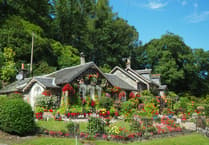LOOE, a quaint fishing port and holiday resort in the corner of South East Cornwall, is typically known for the simpler things of life… like pasties and cream teas (jam first, of course!), writes John Collings.
But ever since Rudyard Kipling acknowledged the role of boats in his 1911 Big Steamers poem, which referred to merchant ships’ pilots being ‘thicker than pilchards at Looe’, this small, sleepy Cornish town has been leaving an indelible mark on the UK’s maritime history.
Kipling’s reference was to a once-thriving fishing industry reliant on the shipbuilding skills that could be found along the twin rivers of East and West Looe.
Times change. Shipwrights have long downed their tools and fishing fortunes are on the ebb with a Brexit dawn yet to rise.
But that boatbuilding heritage is now set to be commemorated with a special ‘Made In Looe’ Regatta being staged in the harbour next June.
From the early 20th century builders, like the Angear, Pengelly and the Ferris families, Looe’s maritime mark continued on to the Pearn brothers, Norman and Gerald, and through to Arthur Collings, Ray Dann, Clifford Adams and Brian Porter among many others.
More recently father-and-son Jim and David Currah’s hand-built wooden Cornish Pilot Gigs have filled eight of the top 10 positions at the World Pilot Gig Rowing championships on the Isles of Scilly.
But perhaps the best known of all the many master craftsmen from Looe was naval architect Alan Pape, whose designs and builds can still be found in many of the marinas in this country and even farther afield.
Mr Pape, who died aged 83 in October 2004, had joined the Curtis and Mitchell team when the ’yard moved upstream from the Canning Factory at Millpool, West Looe, to West Quarries, from where a new fledgling Curtis and Pape operation was soon building more than 1,000 boats for the War Department, including boom defence vessels, minesweepers and steel and wood barges.
After the 1939-45 conflict Mr Pape continued to be responsible for vessels of all shapes and sizes, among the better known ones being Sir Chay Blyth’s 65-ft racing trimaran Brittany Ferries GB, designed by John Shuttleworth, that was launched in 1981 and floated down river on the early morning tide being craned over the picturesque arched bridge that links the east and west Looe communities.
A myriad of boats, featuring virtually every construction method and material conceivable, have been built in Looe over the centuries, including fishing trawlers, leisure craft, sailing dinghies, speedboats and rowing boats.
Next year’s June 14 to 16 regatta weekend will be a celebration of that historic legacy.
It is being organised by the Looe-based Cornish Lugger Association which, since 1989, has been staging biennial regattas for wooden, sail-powered fishing luggers (their name comes from their rather unusual sailing rig), many of them now more than 100 years old.
The association is working in conjunction with Looe Sailing Club, who are no strangers to staging national and dinghy sailing championships; achievements for which they have been shortlisted as National Club of the Year by the Royal Yachting Association.
In addition the Looe Harbour Commissioners, custodians of the tidal port, are waiving mooring dues for the duration of a weekend which will also feature live music on three nights and a fun-filled raft race on the final day, organised by the Looe Boatowners’ Association.
Regatta chairman Jeff Penhaligon, a former submariner and Cornish and Isles of Scilly harbourmaster, said: “We have enjoyed such a great boatbuilding tradition in this town over the years that we felt the time was long overdue that it was recognised and celebrated with an event of its own.”
The search is now on for those with boats ‘Made In Looe’ who could make the reunion a popular reality.
Anyone with a Looe-built vessel can register their interest (without obligation) by emailing details of their vessels to Paul Pengelly at [email protected]
They will then be kept informed of full details as the regatta plans are firmed up in the months ahead.




